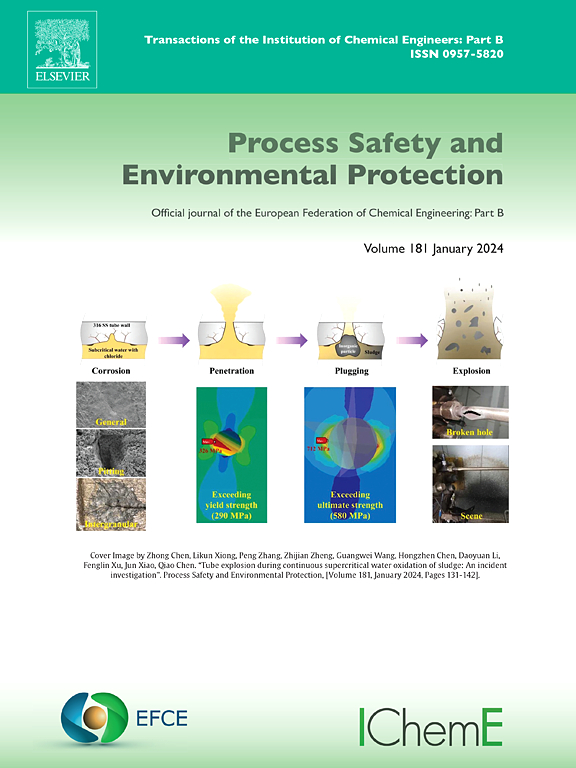Evaluation and Optimization of a cascade PEMFC system for enhancing coalbed methane recovery considering carbon capture and carbon taxes
IF 6.9
2区 环境科学与生态学
Q1 ENGINEERING, CHEMICAL
引用次数: 0
Abstract
In this work, a cascade PEMFC system for enhancing coalbed methane recovery is proposed. Conventional and advanced exergy, exergoeconomic, and exergoenvironmental analyses are performed to determine the irreversibility and identify potential improvements for each component. Use of monoethanolamine solution to absorb the large amount of carbon dioxide produced during the reaction. At the same time, the carbon tax is considered in the exergoeconomic analysis. Multi-objective optimization visualizes the distribution of non-inferior solutions through Pareto front and uses TOPSIS and Shannon entropy methods to determine the optimal solution. The result indicates that the exergy destruction, exergoeconomic and exergoenvironmental impact rates of the system are 298.0251考虑碳捕集和碳税的梯级PEMFC系统煤层气采收率评价与优化
本文提出了一种用于提高煤层气采收率的串级PEMFC系统。进行常规和先进的能源、能源经济性和能源环境分析,以确定不可逆性,并确定每个组成部分的潜在改进。利用单乙醇胺溶液吸收反应过程中产生的大量二氧化碳。同时,碳税也被纳入到经济分析中。多目标优化通过Pareto前将非劣解的分布可视化,利用TOPSIS和Shannon熵方法确定最优解。结果表明,该系统的火用损耗率为298.0251kW,火用经济性为27.8790$/h,火用环境损耗率为424.3612mpts/h。先进的火用破坏、火用经济和火用环境的结果表明,阴极具有最高的可避免的火用破坏和火用经济成本率(分别为51.1256kW和2.5326美元/h)。换热器2具有最高的可避免运行环境影响率,为58.5541 mpts/h。选取总火用破坏率、总火用经济成本率和火用环境影响率3个参数进行多目标优化,发现重整温度为822.39℃时体系最优。本研究为优化这种新型耦合系统提供了更明确的方向。
本文章由计算机程序翻译,如有差异,请以英文原文为准。
求助全文
约1分钟内获得全文
求助全文
来源期刊

Process Safety and Environmental Protection
环境科学-工程:化工
CiteScore
11.40
自引率
15.40%
发文量
929
审稿时长
8.0 months
期刊介绍:
The Process Safety and Environmental Protection (PSEP) journal is a leading international publication that focuses on the publication of high-quality, original research papers in the field of engineering, specifically those related to the safety of industrial processes and environmental protection. The journal encourages submissions that present new developments in safety and environmental aspects, particularly those that show how research findings can be applied in process engineering design and practice.
PSEP is particularly interested in research that brings fresh perspectives to established engineering principles, identifies unsolved problems, or suggests directions for future research. The journal also values contributions that push the boundaries of traditional engineering and welcomes multidisciplinary papers.
PSEP's articles are abstracted and indexed by a range of databases and services, which helps to ensure that the journal's research is accessible and recognized in the academic and professional communities. These databases include ANTE, Chemical Abstracts, Chemical Hazards in Industry, Current Contents, Elsevier Engineering Information database, Pascal Francis, Web of Science, Scopus, Engineering Information Database EnCompass LIT (Elsevier), and INSPEC. This wide coverage facilitates the dissemination of the journal's content to a global audience interested in process safety and environmental engineering.
 求助内容:
求助内容: 应助结果提醒方式:
应助结果提醒方式:


